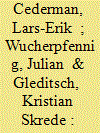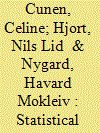| Srl | Item |
| 1 |
ID:
152302


|
|
|
|
|
| Summary/Abstract |
Many scholars have detected a decrease of political violence, but the causes of this decline remain unclear. As a contribution to this debate, we revisit the controversy over trends in conflict after the end of the Cold War. While many made ominous predictions of surging ethnic warfare, Gurr presented evidence of a pacifying trend since the mid-1990s and predicted a further decline in ethnic conflict in an article on ‘the waning of ethnic war’. Leveraging more recent data on ethnic groups and their participation in ethnic civil wars, this study evaluates if Gurr was right about the decline of ethnic conflict, and if he was right for the right reasons. We assess whether an increase in governments’ accommodative policies toward ethnic groups can plausibly account for a decline in ethnic civil war. Our findings lend considerable support to an account of the pacifying trend that stresses the granting of group rights, regional autonomy, and inclusion in power-sharing, as well as democratization and peacekeeping.
|
|
|
|
|
|
|
|
|
|
|
|
|
|
|
|
| 2 |
ID:
173884


|
|
|
|
|
| Summary/Abstract |
Have great wars become less violent over time, and is there something we might identify as the long peace? We investigate statistical versions of such questions, by examining the number of battle-deaths in the Correlates of War dataset, with 95 interstate wars from 1816 to 2007. Previous research has found this series of wars to be stationary, with no apparent change over time. We develop a framework to find and assess a change-point in this battle-deaths series. Our change-point methodology takes into consideration the power law distribution of the data, models the full battle-deaths distribution, as opposed to focusing merely on the extreme tail, and evaluates the uncertainty in the estimation. Using this framework, we find evidence that the series has not been as stationary as past research has indicated. Our statistical sightings of better angels indicate that 1950 represents the most likely change-point in the battle-deaths series – the point in time where the battle-deaths distribution might have changed for the better.
|
|
|
|
|
|
|
|
|
|
|
|
|
|
|
|